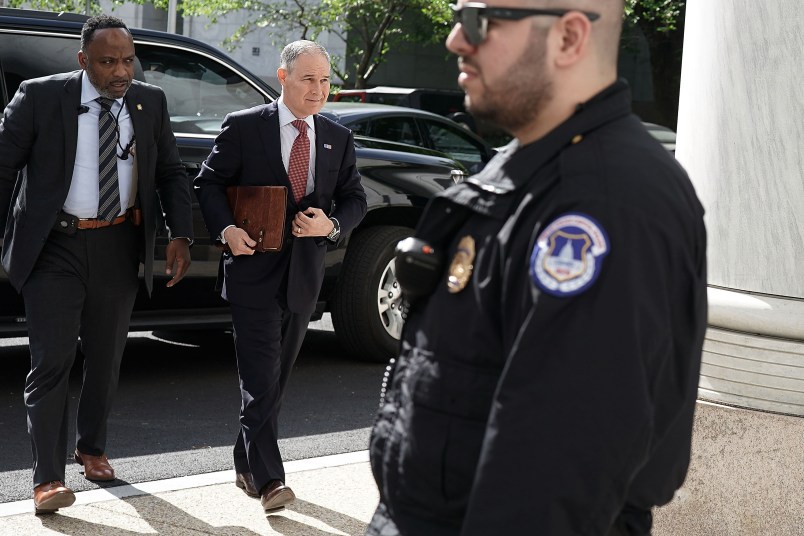The EPA’s Office of Inspector General said in a long-awaited report released Tuesday that taxpayers were asked, without proper justification, to spend far too much on former EPA Administrator Scott Pruitt’s unprecedented 24/7 security detail. Read the EPA IG’s report here, or embedded below.
The Protective Service Detail “incurred over $3.5 million in costs from February 1, 2017, through December 31, 2017—an increase of over 110 percent compared to the prior period’s costs of $1.6 million—without documented justification,” the report’s introduction read.
The EPA IG’s office released a podcast in tandem with the report, found here. (Click here to download the podcast transcript.)
Pruitt resigned in July amid a wave of scandals, including his use of the 24/7 detail as well as a host of other matters — the installation of a practically useless $43,000 phone booth in his office, for example, and a $3,000 sweep of his office for surveillance devices that congressional Democrats later demonstrated wasn’t carried out properly. Pruitt was eventually replaced by a former coal lobbyist, Andrew Wheeler, who’s continued to carry out the President’s industry-friendly deregulatory agenda without all the loud headlines about spending decisions.
“Have you received any documented evidence or justification supporting the decision to provide 24/7 protective service?” EPA OIG spokesperson Tia Elbaum asked at one point in the podcast.
“No, we haven’t,” Jean Bloom of the OIG’s Office and Audit and Evaluation answered plainly.
Bloom noted the EPA attempted to justify the increased security six months after the fact by citing an OIG tally of documented threats made against Pruitt. (The OIG report reaffirmed the office’s earlier findings that the Trump transition team ordered 24/7 security for Pruitt before he was even officially the EPA administrator.)
But as the report noted, that document only “consisted of statistical data of threats received by the OIG” and did not “assess the potential danger presented by any of these threats.”
Much of the report dealt with the authority EPA leadership claimed allowed them to deputize security personnel who otherwise investigated environmental crimes and re-assign them to protect Pruitt.
After refusing to justify the re-assignments for over a year, the EPA eventually told the inspector general’s office that the same law allowing EPA agents to investigate environmental crimes allows agents to be re-assigned to protect the administrator. The OIG took no position on the merits of that legal opinion.
The OIG report also outlined previously reported violations of salary caps and overtime rules for security personnel protecting Pruitt.
“The OIG identified $106,507 of overtime payments made without the proper level of authorization,” the report found, adding that agents in Pruitt’s security detail failed to properly account for the “complex work schedules” that resulted from his 24/7 needs, “with large amounts of overtime, weekend work, shift differentials and Law Enforcement Availability Pay.”
Read the report below:
This post has been updated.







He was afraid that all pissed off chipmunks and rabbits were out to get even.
Pruitt was play-acting as somebody Important because he has huge ambitions for himself. He wants to be a Senator, then President. Even so, these escapades probably make him politically Impotent now more than anything else.
Good timing to release this right at the start of the Kavanaugh hearing’s.
In a normal world, Pruitt would be thoroughly discredited and disgraced by now and un-electable even as dog catcher. In a normal world. But wait for it: Pruitt for President 2024.
Well, at least he was given time for find a suitable hidey hole before this was released.
Anyone know where he is now? BugTussle, Oklahoma?